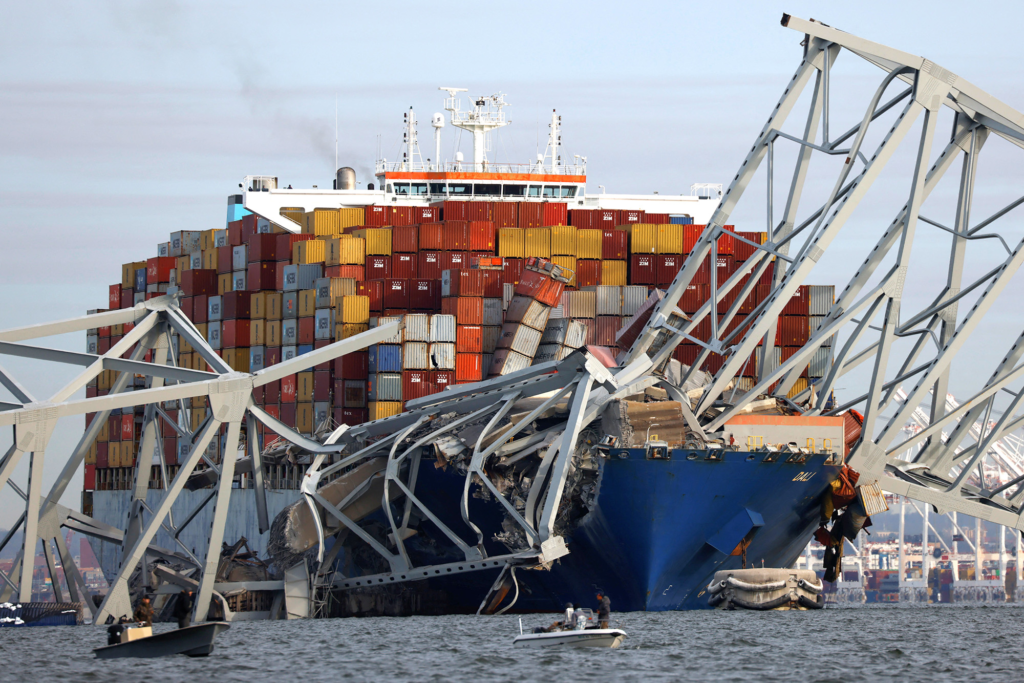I’m sure you’ve all heard about the ship collision with, and the subsequent collapse of the Francis Scott Key bridge in Baltimore by now.
Here are a few details about the entire situation.
The Ship

Let’s start with the vessel involved, the MV Dali. She is a Singapore flagged container ship. Dali had her Keel laid down in 2014 and was commissioned in 2015 and is classed as a post-PANAMAX container ship. She’s 984′ long, 184′ wide and draws 81′ at full displacement weight of 95,128 gross tons. Dali is powered by a single MAN 55,630 hp diesel driving a single fixed pitch thruster for a top speed of 22 knots. Her cargo capacity is 10,000 TEU. TEU stands for “twenty-foot equivalent unit” and is a shipping term that refers to the volume of a shipment in units of 20-foot long containers. A TEU is also the approximate unit of measure for a container, based on its dimensions of 20 feet long, 8 feet wide, and 8.5 feet tall. A TEU can hold between 9 and 11 pallets in one tier and up to 28 weight tons.
The Bridge

Now on to the bridge. The Francis Scott Key bridge connected Baltimore and Dundalk Maryland, spanning the lower Patapsco river. The bridge was 8,636 feet long and carried an estimated 11.5 million vehicles annually. The main span of 1,200 feet was the third longest span of any continuous truss in the world. The bridge was opened on March 23, 1977, named for amateur poet Francis Scott Key (1779–1843), the author of the American national anthem, “The Star-Spangled Banner”. The bridge was the outermost of three toll crossings of Baltimore’s Harbor, two tunnels and one bridge.
The Collision

The ship departed the Seagirt Marine Terminal in the Port of Baltimore at approximately 00:30 local time, sailed northwest past the Nuclear Ship Savanah then turned southeast to depart the harbor, released the tugboats, and collided with the bridge at approximately 01:38. She struck the southwest support column at a speed of 7.6 knots. At some point before the collision, the crew on board alerted Maryland officials that they had lost control of the vessel and a collision with the bridge was possible.
Cameras from the Vessel Traffic Service captured footage of the collision and subsequent collapse. The ship’s lights went out twice before the collision, indicating issues in the engine room. The quick restoration of lighting suggests a full blackout occurred and the emergency generator automatically started to restore basic electrical services and lighting. At 2:22 in the video below, you’ll notice black smoke coming from the funnels indicating an issue with the single engine. I am not a marine engineer, but that indicates, to me at least, that an attempt was made to restart the MAN diesel.
As a side note, if you have any interest in maritime goings-on, you should be following Sal on Twitter or YouTube.
Almost immediately after the collision, the bridge collapsed. Tuesday’s disaster may be the worst U.S. bridge collapse since 2007 when the I-35W bridge in Minneapolis collapsed into the Mississippi River, killing 13. It was the first major collapse of a bridge from a ship impact in about 40 or 50 years, David Knight, a specialist at the Institution of Civil Engineers, told Reuters.
As of this writing, at least eight people were on the bridge at the time of the collision and six remain unaccounted for.
This is a developing story and may be updated.